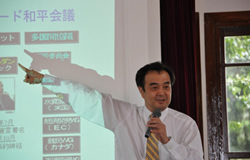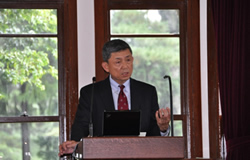Center for Interdisciplinary Study of Monotheistic Religions(CISMOR)Doshisha University
> Public Lectures > Obama’s New Middle East PolicyPublic Lectures
Project 2: Public Lecture
Obama’s New Middle East Policy
| Date: |
2009/07/25 13:00 - 15:00 |
|---|---|
| Place: | Clarke Memorial Hall Chapel, Doshisha University |
| Lecture: |
Noboru Yamaguchi (Professor, School of Defense Science, National Defense Academy of Japan) Kunihiko Miyake (President, The AOI Foreign Policy Institute) |
| Summary: | |
|
“The Obama Administration’s Military Strategy, With a Focus on the Middle East” by Prof. Noboru YAMAGUCHI Drawing on insights gleaned from the Bush Administration’s second term and recently released official documents, Prof. Yamaguchi explained the Obama Administration’s military strategy. The framework of U.S. security strategy is composed of (1) the National Security Strategy, (2) the National Defense Strategy, which the Department of Defense uses to carry out (1), and (3) the National Military Strategy, which each branch of the military and the joint commanders use to carry out (1) and (2). Both (2) and (3) are reviewed every four years with a focus on the structure of the forces; this is the Quadrennial Defense Review (QDR). Taken together, these strategies form the basis of policies, and it is to this groundwork that other initiatives are added, such as the “New Strategy for Afghanistan and Pakistan” released in March of this year [2009]. The QDR released in 2006 differed from those of previous years in that the U.S. revealed the humbling assessment that the U.S. alone and military power alone could accomplish nothing, therefore, the U.S. must build various types of partnerships. It also showed awareness that there must be a shift in priorities away from Cold-War era force maintenance, which assumed conflict using conventional forces (traditional challenges), and toward threats posed by challenges such as terrorism (irregular challenges), the threats posed by rogue states and terrorists employing weapons of mass destruction (catastrophic challenges), and the threats posed by competitors such as Iran, Russia, and China, which have technologies or methods that could overcome the U.S. advantage (disruptive challenges). The significant point of the National Security Strategy and the Quadrennial Roles and Missions (QRM) Report is that the top strategic objective became “homeland security.” Before these reports, the U.S. had not contemplated a direct attack on the homeland. But in the nineties, the impact of North Korea’s augmentation of its Rodong and Taepodong missiles and of the Aum sarin gas attack [in Japan] made the U.S. conscious of its own homeland security. The main responsibility of the military became homeland security and civil support. Traditionally, deterrence through military force had been the foremost priority, so this shift was groundbreaking indeed. The “New Strategy for Afghanistan and Pakistan” shows a divergence from the Bush Administration approach. The Obama Administration places emphasis on Afghanistan, not Iraq, and acknowledges that Afghanistan and Pakistan are inextricably linked. Anti-terrorism policy will not work only by fighting against the terrorists; it must prevent the creation of an environment that fosters terrorists. More than the military aspect, the new strategy focuses on the restoration of order, the reconstruction of society, the development of industry, and the overhaul of governing institutions. Further, it is essential that these efforts are not made by the U.S., but by the local people. The shift in military strategy as described above has come to be reflected on a concrete level. For example, in the “clear, hold, build” strategy, there is no point in “clearing” if a place can’t be “held”; and the new manual on how to deal with uprisings states that the most limited act undertaken by the host country is better than the greatest act undertaken by the U.S. Anti-terrorism policy needs not only the military, but wide cooperation from various stakeholders, and it must be understood that such efforts may take several generations. Emphasizing this point, Prof. Yamaguchi ended his lecture. Ryuji Fujimoto (Research Fellow, CISMOR, Doshisha University) |
|
|
“The Obama Administration’s New Middle East Policy?” by Prof. Kunihiko MIYAKE Miyake explained American policy toward the Middle East by addressing popular beliefs on issues in the Middle East one by one. The first popular belief is that all problems in the Middle East have origins in the Palestinian issue. There is no question that Israel’s occupation is unjustified. Yet if we go back to before the Arab-Israeli War of 1967 (i.e., the “Six-Day War”), this reasoning is no longer tenable. The only country in the Middle East that fought earnestly for Palestine was Egypt; other Arab countries, such as Jordan, Lebanon, and Syria, did not lend their genuine support. In actuality, the Arab countries used the Palestinian issue to support the legitimacy of their own regimes. Therefore, we need to realize that one reason the Middle East is unstable is that the Arab regimes lack legitimacy and the ability to govern. The second popular belief is that the fight against terrorism will continue. It certainly will continue, but we must also pay attention to the aspect of it being “a fight against oneself.” In the Middle East, particularly in the Persian Gulf Region, the balance between the three countries of Iran, Iraq, and Saudi Arabia has been critical. In 1979, an Islamic revolution took place in Iran, and, because the balance between these three countries was disrupted, 1979 also was a revolutionary year in this respect. Seeking to fill the power vacuum, Iraq invaded Iran, and the Soviet Union invaded Afghanistan. In the Afghan conflict, many Mujahedeen fighters were sent from Islamic countries to resist the Soviet Union, and the U.S. supported these fighters. When the Soviet Union withdrew in 1989, the fighters returned home, including those from Saudi Arabia. Around this time, the U.S. military was deployed to Saudi Arabia for the Persian Gulf War, but the returned fighters opposed this, and anti-American sentiment grew rapidly. This is how Al Qaida came to be formed. The U.S. was the one who originally trained these fighters for the Afghan resistance, so the war against Al Qaeda has the aspect of “a fight against oneself.” The third popular belief is that the Jewish lobby controls Middle East policy. The two wheels of U.S. policy on the Middle East, “Israel” and “oil (Arab relations),” must be of similar dimensions for policy to move forward. During George W. Bush’s administration, an axle of idealism—democratization of the Middle East—was added, so it became even more difficult for the wheels to turn. Democratization of the Middle East is indeed advocated by the neo-cons, a group with a significant Jewish presence, and the Obama Administration’s White House Chief of Staff, Rahm Emanuel, is Jewish-American. Yet the Obama administration has not adopted the cause of democratization of the Middle East, and Emanuel is not a neo-con; he’s a mainstream Democrat. It is said that the U.S. has a special relationship with Israel, but the fact that Arab-Americans are not able to exert political influence within the U.S. is an issue as well. The final popular belief is that Obama’s Middle East policy is new. For example, Obama’s speech in June of this year [2009] at Cairo University garnered praise for improving relations with the Islamic world. Nevertheless, it was only the rhetoric that was impressive—there was nothing new on the policy side. The proposed dialogue with Iran is also novel but appears difficult to realize. The new strategy for Afghanistan and Pakistan can be more appropriately understood as a new source of conflict than as a new vision. After making these points, Miyake closed his lecture by predicting that the Obama Administration’s first term would be focused on undoing what eight years of Bush Administration policies had done. Ryuji Fujimoto (Research Fellow, CISMOR, Doshisha University) |
|
|
Handout Prof. Yamaguchi's Mr. Miyake's |
|

